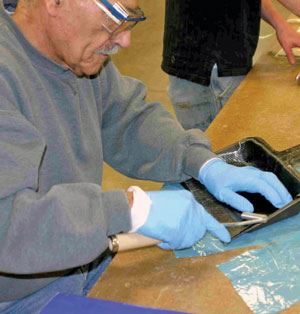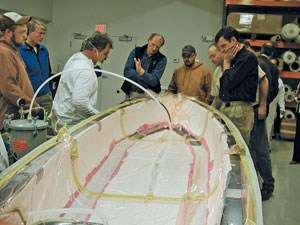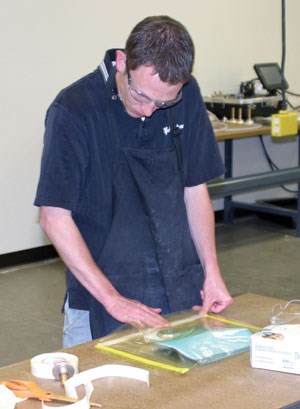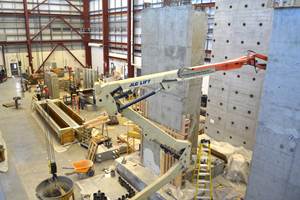Education: Retooling Theory and Practice
To meet the critical need for knowledgeable composites engineers and technicians, public/private partnerships are molding new applications-driven and transportable educational methods.
To meet the critical need for knowledgeable composites engineers and technicians, public/private partnerships are molding new applications-driven and transportable educational models.
The use of composites continues to expand across a wide array of industries, both in new applications and as a replacement material in existing products and structures. In fact, new technologies are being developed and applied at a faster rate than ever before. As a result, composites manufacturers have for some time struggled to overcome a chronic shortage of designers, engineers and shop-floor technicians with adequate knowledge of composite materials and sufficient skills in the design and processing of composite products.
“There needs to be more widespread training,” says Mark Tuttle, chair of the mechanical engineering department at the University of Washington (UW; Seattle, Wash.) and director of the Federal Aviation Admin. (FAA)-sponsored Center for Advanced Materials in Transport Aircraft Structures (AMTAS). “Very knowledgeable composites engineers and technicians are working in the composites industry — there just are not enough of them.”
All too frequently, composites education is handled via informal on-the-job training with a learn-as-you-go attitude, and many formalized engineering programs treat composites as an elective rather than a core part of the program.
“Education in the composites industry is haphazard at best,” admits Gregor Welpton, president of Black Feather Boats (Douglas, Alaska). Although a number of training programs for both engineers and technicians have been spawned over the years, they are essentially independent and, therefore, largely unrelated efforts. The product of universities, community colleges, regional training centers, technical institutes, private training companies and composites vendors, these offerings run a wide gamut from undergraduate and advanced degrees and technical certifications to short courses and periodic seminars. A variety of teaching methods are employed by these programs, including classroom instruction and/or video-based training, video-interactive training and, least likely, hands-on lab work.
“Currently, composites education is being driven by the individual institution,” explains Andre Cocquyt, president of GRPGuru (Brunswick, Maine) and one of the architects of a new composites training curriculum being developed in Brunswick. “There is no consistent approach, no consistent level of education, no qualification,” he adds. The unintended consequence is a dramatic variation in the competency levels of program graduates.
Speaking for many industry business owners, Welpton says the time has come for a coordinated industrywide education effort: “The industry needs an education initiative,” he says, “so that the employers know what they’re getting out of the institutions and the employees know what is expected of them when they show up to work.”
h3. EDUCATIONAL STEPPING STONES
Cocquyt, a vocal advocate for the improvement of composites education, says that the still great need does not negate the individual contributions of education pioneers. He credits the American Composites Manufacturers Assn. (ACMA) specifically for its Certified Composites Technician (CCT) program, which offers training tools in the form of manuals and videos. According to Cocquyt, the program has, in fact, become a “de facto national standard.” But he cautions that CCT certification lacks a critical component — hands-on training (see “Related Content,” at left). Although the CCT pro-gram does require one year of employment in the industry, there is no guarantee that the applicant will have actual manufacturing experience. Someone could earn a CCT certification without ever handling composites material, he notes. “You cannot learn composites in the classroom or by watching a video,” Cocquyt insists. “You have to have a very strong hands-on component.”
Cocquyt believes that technical education belongs in accredited educational institutions, a point with which Jim Hatch, advanced composites instructor at Ogden-Weber Applied Technical College (Ogden, Utah) agrees. “Composites certification should be more than just a test,” he says. “It should be an educational certification, driven by the needs of industry, so that when students have passed a certain certification level, they will have the appropriate skills to do the job.”
Solutions that fit this description are emerging from several sources. Regional economic development initiatives, for example, are driving composites workforce development through collaborative efforts of government agencies, schools and business leaders. Additionally, partnerships between industry and academia are being forged to narrow the gap between the content of school course work and the real-world requirements of shop employees to ensure that students can enter or, for continuing education trainees, re-enter the workforce with up-to-date skills based on the latest materials and technology advancements.
h3. REGIONAL PROTOTYPES
The recent rise of regional training models is the result of collaborative approaches on the part of industry, academia and government entities clustered in a variety of locations across the U.S., including Maine, Utah, South Carolina, Kansas and Washington state.
“When you have education, government and industry meeting as equal partners on a regular basis, you learn very quickly what the current workforce needs are and what they will be down the road,” explains Hatch. “For example, if a company says it’s going to need 200 employees that understand filament winding, then we can look at our programs and try to adapt to meet that need.”
Ogden-Weber, along with Davis Applied Technology College (Kaysville, Utah), offers hands-on composites training as part of a program initiated by the Governor’s Office of Economic Development (GOED) in Utah. Both Ogden-Weber and Davis offer composites technician certificate programs that require a core curriculum of between 400 and 600 hours. “Our students have to be competent in order to get a certification,” says Hatch. “The only grades that we give out are either As or Bs, so they have to be above average to leave the course.” To accommodate students with jobs, classes are taught day and night, and the programs are open entry/open exit — students can start anytime and end anytime.
The GOED’s role is, primarily, to facilitate communication between Utah academic institu-tions — Ogden-Weber, Davis, Utah State University (Logan), the University of Utah (Salt Lake City), and Brigham Young University (Provo) — and the state’s many composites-related companies. Such partnerships with industry have completely changed the focus of community colleges, expanding their mis-sions to include not only edu-cating students but also actively becoming resources for the spe-cific needs of local businesses and the economies in which they operate. For example, The Boeing Co. (Seattle, Wash.) has programs that it teaches during work hours through its in-house Learning, Training and Development (LTD) Group, but it also has partnered with Edmonds Community College (Lynnwood, Wash.) to of-fer a two-year Advanced Materials Degree. Composites technicians are taught layup, maintenance, repair and much more.
Similar partnerships have been established between other businesses and local community colleges. Cerritos College in Norwalk, Calif., is a notable example. It maintains a Composites Training Center and has longstanding training partnerships with Lockheed Martin (Los Angeles, Calif.) and other local composites users, making it possible to offer students access to cutting-edge technology and processes as well as quality materials and equipment.
In Maine, Cocquyt is hoping that the composites training curriculum he’s helping to build may one day be taught at Cerritos and schools like it around the country. “We’re trying to develop a model that will go all the way from high school through a four-year degree,” explains Cocquyt. Currently called The Initiative, the program is funded, in part, by the U.S. Department of Labor’s (DoL) Workforce Innovation in Regional Economic Development (WIRED) program, an additional grant from the DoL, and local investment. The project has brought together a large alliance of government entities, education institutes, private trainers and associations — including GRPGuru, North Star Alliance Initiative (NSAI), the Dept. of Economic and Community Development (DECD), The University of Maine (Orono), Southern Maine Community College (SMCC; Portland), The Landing School (Kennebunkport), the Maine Boat Building Assn., and the Maine Composites Alliance.
The ultimate goal of The Initiative is to establish an accredited two-year Science Degree in Composites that can be used as a blueprint at centers similar to the prototype under development at SMCC’s Maine Advanced Technology Center (MATC, Brunswick, Maine), which officially opened in June 2007. To promote practical, hands-on skills, the MATC has provisioned labs for closed molding and aircraft repair as well as sprayup and wet layup facilities. In all, applications space accounts for roughly 17,000 ft² (1,580m²) of the overall 28,000 ft²(2,600m²) campus.
“The program we’re developing will be the property of the federal Department of Labor and can be handed out and used as a model across the country,” explains Cocquyt, who believes there’s a need for 7 to 10 similar programs around the U.S.
“If we don’t feed the industry with skilled technicians, we’re going to have a problem down the road,” he warns. As materials and processes become more complicated and mistakes more costly, technicians must have both an understanding of composite design and practical knowledge of processes.
Cocquyt is not alone in sounding the alarm. His words are echoed in other regions. “Technicians working with composites must be able to bridge the gap between engineering composite design and the appropriate composite manufacturing method,” says George Gray, dean of the Applied and Engineering Technologies Div., Wichita Area Technical College (WATC, Wichita, Kan.), in a paper presented to the American Society of Engineering Education in 2006, entitled “Advancing Composites Education and Training through Curriculum Design.”
“We’re tackling all the different elements: the existing workforce, workers from other industries, and new workers,” explains Cocquyt. The alliance has even hired someone to make the rounds of local high schools to sell composites as a career. “We’re trying to revive interest in jobs that use both hands and brains,” he says. “Right now we have an amazing cross culture of students, ranging from high school graduates and graduate students to experienced workers and PhDs.” According to Cocquyt, in the geographic region the ATC serves, there are approximately 2,000 people currently in jobs or entering jobs in the composites industry who need a skills upgrade in composites.
h3. THEORY + PRACTICE
One of the greatest needs, from the employers’ perspective, is hands-on materials and processes training for those who, on the job, will not manufacture composites but must nevertheless understand the manufacturing process. Prime examples are manufacturing de-sign engineers who are in transitional industries — those in which composites are beginning to replace legacy ma-terials. Much of the knowledge base on which design engineers in transitional industries draw upon is steeped in the traditions of metalworking.
“We often get design drawings that look perfect, but in reality just can’t be done with composites,” says John Janicki, VP at custom moldmaker Janicki Industries (Sedro-Woolley, Wash.). Janicki, which regularly holds formal in-house training, not only for new employees but also to prepare its technicians for upcoming projects and to hone specific skill sets, recently held a two-day training course at its plant for several NASA engineers who were working with the company on a project. According to Janicki, the engineers, several of whom hold doctorates, were tasked with designing composite components yet had never worked with them. “By getting their hands on the material, they were better able to understand issues like wrinkling and the importance of radiuses, all of which they can apply when designing a structure.”
“These experienced and capable people now need training in the use of polymeric composites,” says UW’s Tuttle. Short courses at colleges as well as private training companies like Abaris Training Resources (Reno, Nev.) and Advanced Composites Training (ACT, London, Ontario) are viable solutions for addressing the skills gap faced by practicing engineers and technicians.
“We fill the gap between the guy who has worked on the shop floor for 20 years and knows everything about the mechanics of what he does but nothing about why he does it, and the guy with the PhD who knows everything about why but may have little practical experience,” says Abaris’ president Michael Hoke.
Although ACT and Abaris cater to the aerospace and defense industries, Hoke has seen his customer base widen to other markets in the past four years. The company offers 15 courses. Four are geared for degreed engineers and are heavy on the mathematics, but all integrate shop floor experience.
“We have a course on repair analysis for engineers in which the engineer has to design a repair for a damaged, heavily loaded structure,” explains Hoke. “As part of the process we take the engineers into the shop and give them damaged carbon fiber panels. There are a number of panels, and each is prepared in a different way. The engineers must do the repairs and then calculate, based on the math, what they think load strength will be after curing. We then physically break the cured panels on a tensile tester to compare the real numbers with the calculated data. Many of the engineers are surprised by the results.”
The lack of practical knowledge is a problem that Tuttle believes begins at the root of engineering education. “The curriculums at engineering colleges and universities need to be adjusted to reflect the increased importance of polymer-based composites,” he says. The required curriculums of many accredited engineering degree programs include at least one introductory course devoted to materials and a second devoted to manufacturing, he explains. However, due to historical importance, these required courses inevitably focus on metals and metal alloys and the manufacturing methods used to produce metallic structures. “Courses devoted to polymers and polymeric composites are usually available but are not a required part of the curriculum,” he adds. “Hence, only a fraction of the engineering graduates are exposed to composites during their college careers.”
“Composites as both a material and application must be more widely introduced to all mechanical/manufacturing engineering and engineer-ing technology students,” says WATC’s Gray. “It should not be buried inside an undergraduate course with just a brief overview, nor should it be strictly treated as a precious commodity reserved only for graduate research labs.”
A 2002 survey conducted by the American Society of Civil Engineers’ Journal of Composites for Construction showed that, of the 41 U.S. schools that participated in the survey, only 24 percent reported offering a dedicated course on FRP composites to undergraduates, while 43 percent offered a dedicated course for graduate students. Today, a quick Internet search reveals that only 28 North American universities purport to have a composites program, and many of these are tied to aerospace programs. Most have developed composites centers or labs dedicated to R&D activities in various areas of composites technology. Many of these, including programs at the University of Delaware’s Center for Composites Materials (CCM, Newark, Del.) and Georgia Tech’s Composites Education and Resource Center (CERC, Atlanta, Ga.), incorporate multi-disciplinary undergraduate and graduate studies in composites. Yet Winona State University’s (WSU, Winona, Minn.) Composites Materials Engineering (CME) department is the only undergraduate engineering program clearly identified as dedicated solely to the study of composites materials.
h3. MODEL PARTNERSHIPS
Although it was originally developed as a tool to help transition its and its strategic partners’ employees from metals to composites, another of Boeing’s partnerships, developed with the University of Washington, and the resulting Advanced Composites Certificate Program, has become a viable model for professional development. “Integrating the university mission (teaching to think) with the corporate model (teaching to do) is a powerful experiential model,” says Michael Richey, associate technical fellow, Boeing’s LTD Group. “We leverage leading faculty from UW to teach the theoretical … and the actual case studies and design analysis work is taught by Boeing employees — primarily technical fellows.”
Codeveloped by the UW departments of Aeronautics and Astronautics, Mechanical Engineering, and Materials Science and Engineering and Boeing’s LTD group, each of the three certificate programs — Aircraft Composite Structural Analysis and Design, Aircraft Composites Materials and Manufacturing, and Modern Aircraft Structures — consists of 100 to 110 hours of instruction and an estimated 220 hours of homework. To date, 180 Boeing employees have earned certificates.
Preliminary planning was required to deal with cultural and contextual differences, develop standards, and set specific and measurable learning objectives. The key to successfully building such a program is building a trusting relationship, says Richey. “Many … university/industry models fail because the participants don’t honor what each other brings to the table.”
h3. JUSTIFYING THE COST
Because much of the responsibility and financial burden for current composites training falls to the employer, it is critical to assess the value of available training options and measure return on investment.
In some instances, it’s easy to justify the cost of outsourced training. Aircraft repair, for example, has the potential for a huge return on investment, in Hoke’s mind. Not only are the structures critical, but they are also costly. “If you have the knowledge to repair a structure for $2,000 to $3,000 that would cost $250,000 to replace, you’re saving your company a lot of money,” he says. “And learning to do a composite repair correctly is not something you can learn from a manual.”
In many cases, however, it’s more difficult to evaluate the investment. “If you’re a company that’s going to invest $4,500 to send your employee through a certificate program like the one we’ve developed at UW,” says Richey, ”currently there is no way to know how much of the program’s knowledge is applicable or what the employee is going to do with that knowledge in terms of driving product or process efficiencies.”
To that end, Boeing and UW partnered to measure the perceived learning value and impact of their program, “taking assessment to a new level,” according to Richey. “Our approach to assessing return on investment … involved mea-suring whether the knowledge transferred, whether the knowledge changed their behavior, and whether that behavior impacted productivity of the part or assembly.”
The process enabled Boeing to map the learning, behavior and performance objectives that were developed in the class, and the LTD group calculated return on investment of more than 500 percent for the Aircraft Composites Structural Analysis and Design program. “Our Learning Return on Investment process validated the investment,” claims Richey. “When the employee comes back with this knowledge, they’re going to be more productive, they’re going to design more efficiently, they’re going to lower the complexities of the designs on which they’re working.”
Related Content
Recycling end-of-life composite parts: New methods, markets
From infrastructure solutions to consumer products, Polish recycler Anmet and Netherlands-based researchers are developing new methods for repurposing wind turbine blades and other composite parts.
Read MoreComposites end markets: Infrastructure and construction (2024)
Composites are increasingly used in applications like building facades, bridges, utility poles, wastewater treatment pipes, repair solutions and more.
Read MoreKU researchers explore FRP materials for dams, levee reinforcement
To address aging infrastructure, a team of researchers at KU is conducting research into repairing and retrofitting 700-plus dams, levees and related structures nationwide using FRP materials.
Read MoreComposites reinvent infrastructure
Celebrating National Composites Week, CW shares ways in which composites continue to evolve the way we approach infrastructure projects.
Read MoreRead Next
Plant tour: Daher Shap’in TechCenter and composites production plant, Saint-Aignan-de-Grandlieu, France
Co-located R&D and production advance OOA thermosets, thermoplastics, welding, recycling and digital technologies for faster processing and certification of lighter, more sustainable composites.
Read More“Structured air” TPS safeguards composite structures
Powered by an 85% air/15% pure polyimide aerogel, Blueshift’s novel material system protects structures during transient thermal events from -200°C to beyond 2400°C for rockets, battery boxes and more.
Read MoreDeveloping bonded composite repair for ships, offshore units
Bureau Veritas and industry partners issue guidelines and pave the way for certification via StrengthBond Offshore project.
Read More























